Hitachi Deskstar 7K1000 in RAID 0: Is Two Terabytes really better than One?
by Gary Key on April 19, 2007 12:15 AM EST- Posted in
- Storage
Actual Application Performance
Our application benchmarks are designed to show application performance results with times being reported in seconds, with lower scores being better. While these tests will show some differences between the drives it is important to understand we are no longer measuring the pure performance of the hard drive but how well our platform performs with each individual drive. In that sense, these are the more real-world tests that show how hard drives and RAID 0 can impact your everyday computer use.
The performance of a hard drive is an integral part of the computer platform but other factors such as memory, CPU, core logic, and even chipset driver choices can play a major role in determining how well the hard drive performs in any given task. Also worth noting is that new features of Windows Vista - specifically SuperFetch - can further reduce the measured performance differences between hard drives.
Game Load Tests
In our Half-Life 2: Lost Coast test we measure the time it takes to load the game with the application timer starting when the play game icon is initiated in the Steam menu until the main game menu appears.
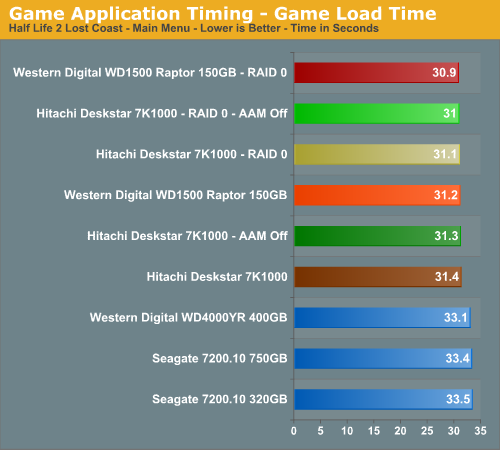
The results speak for themselves with the RAID 0 setups offering extremely minor performance improvements in actual game load testing. You will likely not be able to notice any differences during actual game play with a RAID 0 setup. We know it was impossible for us.
Our Sims 2 - Open for Business test measures the time it takes to load the initial portion of the game. Our application timer starts when the game icon is initiated until the neighborhood menu appears.

We witnessed 38% to 50% improvements in our iPeak tests in this game but measure less than a 2% difference in actual game load times. Without a benchmark, these differences are impossible to witness during actual game play. Once again, we see the Raptors slightly ahead but the 7K1000 for all intents and purposes is even in our game benchmarks.
Game Level Load
This test centers on the actual loading of a playable level within our game selections. We run Battlefield 2 and measure the time it takes to load the Daqing Oilfields level. Our application timer begins when the start single player icon is initiated and ends when the join game icon is visible.
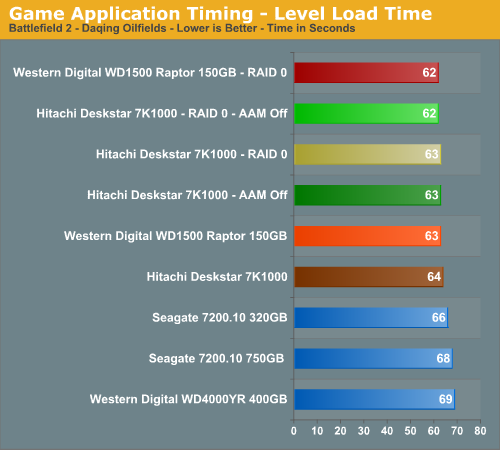
Once again we see a minimal difference between our RAID 0 and single drive configurations in this benchmark with only a one second difference in load times. In repeated testing it was difficult to discern any differences between the RAID 0 and single drive setups. On a side note, we firmly believe the areal density and 32 MB cache advantages of the Hitachi 7K1000 make up for the rotational and random access advantages of the Raptor in our gaming tests.
WinRAR 3.62
Our WinRAR test measures the time it takes to compress our test folder that contains 444 files, 10 folders, and 602MB of data. This is same test folder utilized in our iPeak test suite. This benchmark is extremely CPU/RAM intensive but it may require a fast storage system to keep pace.
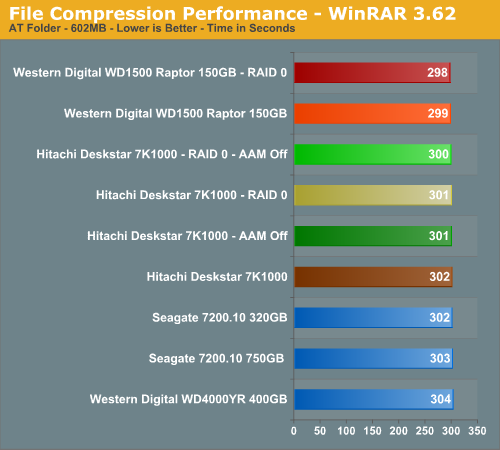
Our iPeak test showed a 50% advantage for the RAID 0 setups but we see an insignificant difference in the actual test results. One would assume the potential write speed advantages of a RAID 0 setup would have a larger impact on performance in this benchmark but in actuality CPU throughput makes a far more significant difference.
Nero Recode
Our encoding test is quite easy - we take our original Office Space DVD and use AnyDVD Ripper to copy the full DVD to the hard drive without compression, thus providing an almost exact duplicate of the DVD. We then fire up Nero Recode 2, select our Office Space copy on the hard drive, and perform a shrink operation to allow the entire movie along with extras to fit on a single 4.5GB DVD disc. We leave all options on their defaults except we turn off the advanced analysis option. The scores reported include the full encoding process and are represented in seconds, with lower numbers indicating better performance.
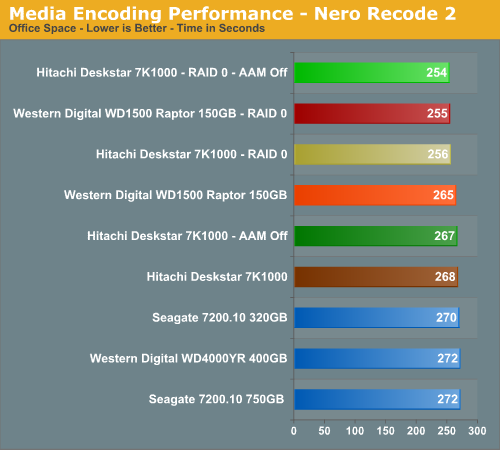
The iPeak results showed a 93% improvement with RAID 0 and we know from previous experience that RAID 0 can make a difference in this particular test. How large the difference would be was anybody's guess, but we figured it was the last chance for RAID 0 to generate any meaningful performance improvements. In the end, we did have measurable differences between the two setups with the RAID 0 configurations performing about 5% better. If you do a lot of video encoding then RAID 0 could end up saving you some precious minutes each day. Is it worth the cost or effort? Probably not, but it is one area besides benchmarking where RAID 0 actually made a difference. Of course, if you don't already have the fastest CPU for encoding available, that would have a far greater impact than RAID 0.
File Copy Performance
Our file copy test measures the time it takes to transfer our test folder that contains 29 files, 1 folder, and transfers 7.55GB of data from our source drive to the target test drive. This is same test folder utilized in our iPeak test suite. This benchmark is disk write intensive and requires a fast storage system.
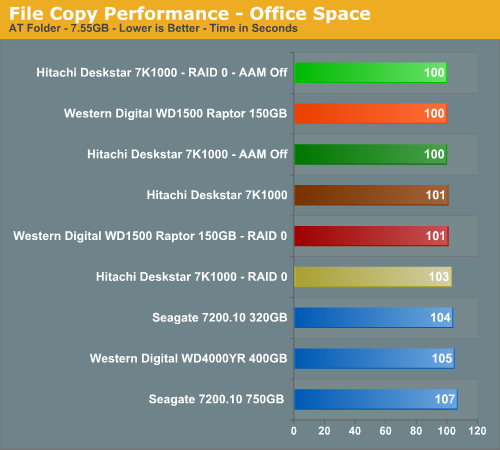
We finish our tests with a benchmark that should have favored the RAID 0 setups due to a pure write scenario. Unlike our iPeak test (and for that matter a similar test in PCMark05) where the largest differences in scores between setups were generated, we have RAID 0 making no difference in this test and actually scoring worse than a single drive setup in two instances.
Our application benchmarks are designed to show application performance results with times being reported in seconds, with lower scores being better. While these tests will show some differences between the drives it is important to understand we are no longer measuring the pure performance of the hard drive but how well our platform performs with each individual drive. In that sense, these are the more real-world tests that show how hard drives and RAID 0 can impact your everyday computer use.
The performance of a hard drive is an integral part of the computer platform but other factors such as memory, CPU, core logic, and even chipset driver choices can play a major role in determining how well the hard drive performs in any given task. Also worth noting is that new features of Windows Vista - specifically SuperFetch - can further reduce the measured performance differences between hard drives.
Game Load Tests
In our Half-Life 2: Lost Coast test we measure the time it takes to load the game with the application timer starting when the play game icon is initiated in the Steam menu until the main game menu appears.

The results speak for themselves with the RAID 0 setups offering extremely minor performance improvements in actual game load testing. You will likely not be able to notice any differences during actual game play with a RAID 0 setup. We know it was impossible for us.
Our Sims 2 - Open for Business test measures the time it takes to load the initial portion of the game. Our application timer starts when the game icon is initiated until the neighborhood menu appears.

We witnessed 38% to 50% improvements in our iPeak tests in this game but measure less than a 2% difference in actual game load times. Without a benchmark, these differences are impossible to witness during actual game play. Once again, we see the Raptors slightly ahead but the 7K1000 for all intents and purposes is even in our game benchmarks.
Game Level Load
This test centers on the actual loading of a playable level within our game selections. We run Battlefield 2 and measure the time it takes to load the Daqing Oilfields level. Our application timer begins when the start single player icon is initiated and ends when the join game icon is visible.

Once again we see a minimal difference between our RAID 0 and single drive configurations in this benchmark with only a one second difference in load times. In repeated testing it was difficult to discern any differences between the RAID 0 and single drive setups. On a side note, we firmly believe the areal density and 32 MB cache advantages of the Hitachi 7K1000 make up for the rotational and random access advantages of the Raptor in our gaming tests.
WinRAR 3.62
Our WinRAR test measures the time it takes to compress our test folder that contains 444 files, 10 folders, and 602MB of data. This is same test folder utilized in our iPeak test suite. This benchmark is extremely CPU/RAM intensive but it may require a fast storage system to keep pace.

Our iPeak test showed a 50% advantage for the RAID 0 setups but we see an insignificant difference in the actual test results. One would assume the potential write speed advantages of a RAID 0 setup would have a larger impact on performance in this benchmark but in actuality CPU throughput makes a far more significant difference.
Nero Recode
Our encoding test is quite easy - we take our original Office Space DVD and use AnyDVD Ripper to copy the full DVD to the hard drive without compression, thus providing an almost exact duplicate of the DVD. We then fire up Nero Recode 2, select our Office Space copy on the hard drive, and perform a shrink operation to allow the entire movie along with extras to fit on a single 4.5GB DVD disc. We leave all options on their defaults except we turn off the advanced analysis option. The scores reported include the full encoding process and are represented in seconds, with lower numbers indicating better performance.

The iPeak results showed a 93% improvement with RAID 0 and we know from previous experience that RAID 0 can make a difference in this particular test. How large the difference would be was anybody's guess, but we figured it was the last chance for RAID 0 to generate any meaningful performance improvements. In the end, we did have measurable differences between the two setups with the RAID 0 configurations performing about 5% better. If you do a lot of video encoding then RAID 0 could end up saving you some precious minutes each day. Is it worth the cost or effort? Probably not, but it is one area besides benchmarking where RAID 0 actually made a difference. Of course, if you don't already have the fastest CPU for encoding available, that would have a far greater impact than RAID 0.
File Copy Performance
Our file copy test measures the time it takes to transfer our test folder that contains 29 files, 1 folder, and transfers 7.55GB of data from our source drive to the target test drive. This is same test folder utilized in our iPeak test suite. This benchmark is disk write intensive and requires a fast storage system.

We finish our tests with a benchmark that should have favored the RAID 0 setups due to a pure write scenario. Unlike our iPeak test (and for that matter a similar test in PCMark05) where the largest differences in scores between setups were generated, we have RAID 0 making no difference in this test and actually scoring worse than a single drive setup in two instances.










48 Comments
View All Comments
Pirks - Thursday, April 19, 2007 - link
call it a waste after you lose a terabyte of data because you hdd died on ya, until then - move alongyyrkoon - Thursday, April 19, 2007 - link
BTW, those of us who are truely serious about their data, do not keep the data stored on HDD alone. Tape, offsite, optical, choose your poison.Pirks - Friday, April 20, 2007 - link
for me number one reason for data loss was ALWAYS hdd failure, those caviars that click to death. I've never experienced data loss for any other reason. hence my natural impulse is to put two hdds in mirror raid - this eliminates most potent threat. and striping only doubles it, plus striping only slows things down when you copy big files (video mux/demux and stuff like that) so for me its mirror only (plus extra drive to speed up file copies a LOT)yyrkoon - Thursday, April 19, 2007 - link
If you are smart about how you use your HDDs, you will have no need, BUT if it makes you feel all warm and fuzzy inside, more power to you. The rest of us, who live in reality, and have HDDs much older than 10 years old, still functional, know better.Pirks - Friday, April 20, 2007 - link
yeah, I have 80 gig wd that I bought I forgot when, 5 years ago? maybe more... it's hot and noisy but looks like it's immortal. however, I wish ALL hdds were like this one. which they are not, unfortunately. those who experienced dead hdds (without doing anything special, just hdd that suddenly dies on you after a couple of years of excellent service) know better than youmlambert890 - Thursday, April 19, 2007 - link
it's not hundreds of dollars, its not insane, and you are wrong. its really kind of amusing that people are "debating" the basic premise of if a stripe set yields better read performance as if this were some new invention newly discovered and untested!Boushh - Thursday, April 19, 2007 - link
Well, maybe not hunderds of dollars (I agree that putting two of these 1 TB drive in RAID 0 is not very usefull) but if you go down the price list you can buy 2 320 Gb drives and put them in RAID 0. They are not expensive, and I know from my own experience that it realy makes a difference. All disk based activity is a lot faster than it would be on a single drive.I've may OS and my games on the RAID 0, and it realy helps speeding things up. So when the price is right RAID 0 is the way to speed up disk activity.
DigitalFreak - Thursday, April 19, 2007 - link
*sigh*mlambert890 - Thursday, April 19, 2007 - link
sigh all you want, but this is not up for debate. Many of us spend all day every day building and operating RAID systems. maybe for you, one article from anand that confirms some weird bias you have is sufficient. for those of us with 20+ years of doing this, the benefits of multiple spindles really dont need to be retested, and reproven, to make yet another generation feel cozy.synthetic benchmarks arent operating in some alternate reality. if whatever you are doing on your pc involves moving large, linear, blocks of data then you will benefit from a throughput boost clearly. in this case, a stripe set will yield quantitative benefit.
for many, loading something (even a game) seconds faster has value. esp since raid 0 has become a complete commodity. pointless article really, and pointless comments from the clueless. raid 0 has been written about and analyzed by smarter poeople with better measurement tools for decades. maybe people should try using common sense and broadening their google searches (that is if collecting their own real world experience is too much trouble)
OrSin - Thursday, April 19, 2007 - link
I got 20 years plus experience working in server farms and Raid is great from 0 to 5.With that said desktop raid dont do crap. I have over 10 systems in my house most on the extra same hardware. I tested Raid 0 and raid 5 and the difference in transfer speed even from GB switchs in less then 8%. Sorry but unless the maps or levels are just sitting in cache it don't do anything. Most of the delay is in seek time and Raid dont improve that at all. In fact I beleive it slows it (no proof). Please with all your experience the desktop and Server space is very different. Also remember SCSI raids improve seek time alot. I think if SATA hardware raids improve then raiding desktop might help.
PS
What are people doing they they even need a 50% improvement in hardrive speed on a desktop? Load levels and map? Sorry but saving even 5 secs out of 10, 5 times a day is not work the extra money to me. CPU, Ram, and Video cards scale so much better. You want the speed make a ram disk. :)